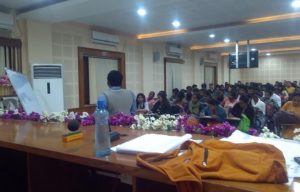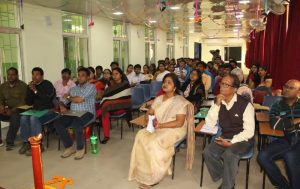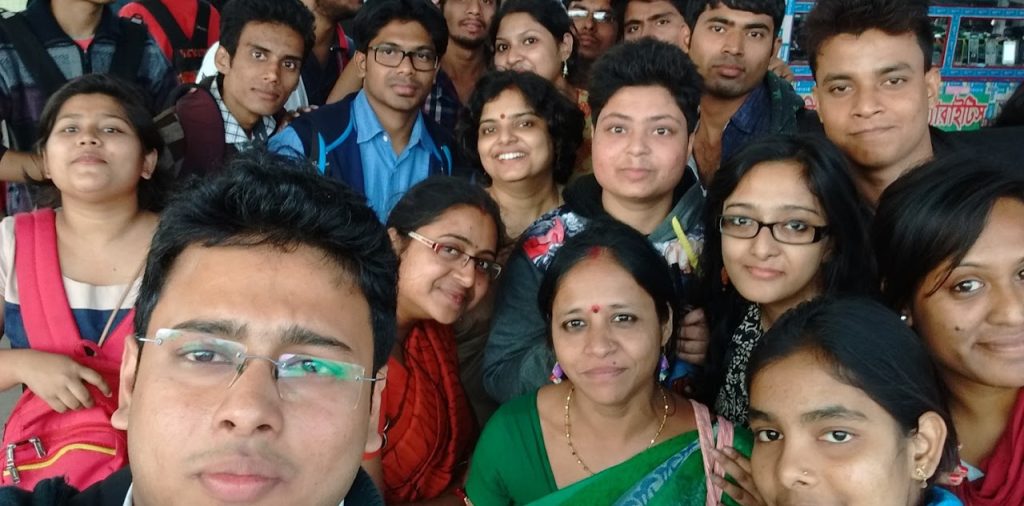Zoology
- About Department
- Departmental Composition
- Program & Courses
- Announcement
- Departmental Activities
- Student Support & Student Activities
- Student Connect
- Miscellaneous
Surendranath College is an undergraduate college affiliated to the University of Calcutta, in Kolkata, India. It was founded in 1884 by the nationalist leader and scholar Surendranath Banerjee. For much of its history it was known as Ripon College, named for the British Viceroy Lord Ripon, but in 1948-1949 it was renamed for its founder. Swami Vivekananda delivered his first address in Calcutta from the rostrum of this college on his return from Chicago after his famous deliverance at the Parliament of the World’s Religions. The Journey of Department of Zoology dates back to the year 1959. One of the pioneer departments in this college to have an honours course.
Departmental Website: https://sites.google.com/view/snczoology/home
Distinctiveness
- The Journey of Department of Zoology dates back to the year 1959.
- One of the pioneer departments in this college to have an honours course.
- It’s a DBT star department.
- Department receives funding from both BOOST and STAR in a single academic year.
- Collaboration with IIT BOMBAY.
- A well-furnished animal specimen museum having a diverse collection of animal species from different ecological habitats, several preserved rare specimens, skeletal structures, corals and taxidermy collections, providing the students an opportunity to know about the animal kingdom through a visionary learning and understanding of the different animal species.
- A spacious Department having 3 laboratories, 3 classrooms (out of them, 2 ICT enabled air conditioned) , 1 seminar room, 1 seminar library,1instrument room ,1store room , 1 Teacher’s room and an office for HOD. Two digitally smart classrooms with well-equipped infrastructure for imparting better, detailed and picturesque illustration of the academic/curricular topics to the students. An instrument room with all the required instruments for the demonstration and illustration of practical academic/curricular topics to the students, providing them with a hand-on experience in the operation of the instruments. The instruments present in the instrument room are – Binocular microscope, Incubator, Compound microscopes, Agarose Gel Electrophoresis apparatus, Protein Gel Electrophoresis apparatus (SDS-PAGE), Histological staining apparatus (Vials, Trays, Hematoxylin, Eosin ), Instruments for the Ecological experiments (burettes, conical flasks, beakers, pipettes, BOD bottles).
- Study tour and Field trips conducted by the department for the exposure of students to the diverse animal species and their ecological habitats in nature.
- A departmental library for the students to have a good collection of books to read and borrow to enrich themselves with the academic/curricular topics to enhance their subject concepts and dept.
- Involving students in different extra-curricular activities like – Student’s Seminar programs, Writing of Review articles, publishing departmental e-Magazine to encourage students to write and publish articles of their topic of interest, organizing Intra/Inter departmental Quiz competitions among the students to exercise and widen their horizon of knowledge and thinking.
Best Practices
- Student’s seminar program
- Publication of e-magazine
- Alumni meet
- Parent-Teacher meeting
- Educational and study tour
- Mentor-mentee groups and interactions
- Departmental Seminar/Webinar
- Departmental cultural programs (Fresher’s welcome, Farewell, Teacher’s day)
The program provides the awareness to the students about knowledge and skill in the fundamentals and systematics of animal kingdom. The students gain the knowledge of anatomical structure and various metabolic functions of organisms and understand the various physiological processes at molecular level of animals from different phyla. Information and skill of advanced biological techniques for experimental purpose are inculcated among the students. Students are exposed on the awareness about environment and its conservation processes, pollution control and its importance and gaining of knowledge of protection of vulnerable and endangered species. Information and knowledge skill of applied zoology including sericulture, apiculture, fisheries, poultry, vermiculture, agricultural pests and their control etc. are provided to the students with pragmatic understanding and knowldedge. Students are made to learn about various concepts of genetics and its importance in social wellbeing and are made aware about ethical principles and commit to professional ethics and responsibilities. Students are made to understand the application of knowledge and understanding of Zoology to one’s own and social life along with the gaining of knowledge concerning communicable and non-communicable diseases to improve personal and public health.
Program specific Outcome
The student will be able to understand classify and identify the diversity of animals. The student understands the importance of classification of animals and classifies them effectively using the six levels of classification. The student knows his role in nature as a protector, preserver and promoter of life which he/she has achieved by learning, observing and understanding life. . Acquire knowledge on the various aspects of life sciences, cell biology, genetics, taxonomy, physiology, applied zoology, general embryology and public health. Understand good laboratory practices and safety, Carry out experimental techniques and methods of Physiology, Cell biology, pathology, Genetics, Applied Zoology, Biological techniques, Toxicology, Entomology, Sericulture, Biochemistry, Microtomy. Understand the applications of biological sciences in Biotechnology, Apiculture, Poultry, Fisheries, Aquaculture, Agriculture and Vermiculture. The students gain the knowledge to use modern sophisticated equipments and tools. Recognize the scientific facts behind natural phenomena. In the Practical papers the students gain knowledge to identify various animals based on morphological features and understand the principle and use of microscopes and micrometry.
Course Specific Outcomes
The courses is delivered in terms of concepts, mechanisms, biological designs & functions and evolutionary significance cutting across organisms at B.Sc. level. This courses will be studied by students of all branches of biology. Both chalk and board, and PowerPoint presentations are used for teaching the course. The students perform dissertation/ project work under practical of different courses, wherever possible. The students are expected to learn the courses with excitements of biology along with the universal molecular mechanisms of biological designs and their functions. They will be able to appreciate shifting their orientation of learning from a descriptive explanation of biology to a unique style of learning through graphic designs and quantitative parameters to realize how contributions from research and innovation have made the subjects modern, interdisciplinary and applied and laid the foundations of Zoology, Animal Sciences, Life Sciences, Molecular Biology and Biotechnology. This courses and their practical exercises help the students to apply their knowledge in future course of their career development in higher education and research. In addition, they become interested to look for engagements in industry and commercial activities employing Life Sciences, Molecular Biology and Biotechnology. They can also be interested in entrepreneurship and start some small business based on their interest and experience.
The core courses would fortify the students with in-depth subject knowledge concurrently; the discipline specific electives will add additional knowledge about applied aspects of the program as well as its applicability in both academia and industry. Generic electives will introduce integration among various interdisciplinary courses. The skill enhancement courses would further add additional skills related to the subject as well as other than subject. In brief, the students graduated with this type of curriculum would be able to disseminate subject knowledge along with necessary skills to suffice their capabilities for academia, entrepreneurship and Industry.
Non- Chordates I (Protista to Pseudocoelomate)
Students become familiar with the non-chordate world that surrounds us. Able to appreciate the process of evolution (unicellular cells to complex, multicellular organisms) Able to identify the invertebrates and classify them up to the class level with the basis of systematic Understand the basis of life processes in the non-chordates and recognize the economically important invertebrate fauna.
Molecular Biology
The students are enriched with the knowledge on the genetic variation through linkage and crossing over, gene frequency, chromosomal aberrations and sex determination. Understand the theories of classical genetics and blood group inheritance in man. Explain the concept of mutation and DNA structure. Paraphrase the Central dogma of molecular biology. Understand the molecular structure of genetic materials and understood the mechanism of gene expression and regulation character formation. Illustrate the mechanism of replication, transcription and translation. Justify the post transcriptional and post translational modifications.
Non-Chordate II (Coelomate Phyla)
The students get a detailed introduction to Coelomate non-chordate phyla with a detailed understanding of the different morphological, anatomical, physiological, ecological and evolutionary significances related with them. Students receive an enriched knowledge on the detailed understanding of Annelid, Arthropoda, Mollusca, Echinodermata.
Cell Biology)
The students are able to understand the structure of cells and cell organelles in relation to the functional aspects and understanding of the working principles and applications of microscopes. Describe the composition of prokaryotic and eukaryotic cells. Understand the structure and functions of chromosome; mitotic and meiotic cell divisions and their significance. Describe the three primary components of the cell’s cytoskeleton and how they affect cell shape, function, and movement. Differentiate between structural, functional and biochemical aspects of all the cellular components and organelles. Acquire a well gained knowledge of cell transportation, gap and tight junctions and all other cellular activities and physiology.
Chordata
The students get to identify the characters of Amphibia and its parental care. To describe the Phylum Mammalia and its aquatic adaptations. To identify the poisonous and non-poisonous snakes. To write down classification of Aves and Flight adaptation in birds. To identify the formation of foetal membranes in chick embryo and their function.
Animal Physiology: Controlling & Co-ordinating system
Students are introduced to the very basics and fundamental approaches to the Neuroscience and Nervous system. Understand and analyze the significance of Ion channels and Neurotransmitters in the functional, physiological and biochemical study of the Neurobiology and Nervous system. Understanding of cellular and molecular basis of neurophysiology. Students learn to understand and acquire knowledge in the techniques to study brain.
Fundamental of Biochemistry
Students gain the knowledge of basic terms in biochemistry. The student will be able to explain the structure, functions and reactions of the various biomolecules. Correlate the changes in the levels of these biomolecules with the diseases in human. Calculate pH of buffer solution. Attained the knowledge of macromolecule such as carbohydrates, protein and fat, their types and significance. Understand and analyse the enzymes, mechanism of enzyme action and factors affecting the enzyme activity and the various types and importance of vitamins.
Comparative Anatomy of Vertebrate
The students are taught and enriched in their knowledge about the comparative structures of heart, aortic arches, kidney, balancing organ, hearing organ, thyroid, respiratory organs, brain of different animals which give them a definite idea not only the structure but also the structural development of that organ and how they become modified according to their need and environment. Students get a brief idea and knowledge about differentiation and organization of cells and maintenance of tissues. It helps to get a better idea about their structure and function.
Animal Physiology: Life Sustaining System
The students learn to describe the anatomy of different physiological systems at the tissue and cellular levels. Evaluate the physiological functioning of different organs. Analyse the physiological changes in relation to environmental conditions. Identify different tissues related to anatomy and physiology from an evidence-based perspective. Carry out physiological studies in the laboratory, Interpret data and graphs and write a report. Correlate the organisms Internal and external environments with homeostasis and biological clocks. Justify energy utilization in physiological and metabolic activities.
Immunology
The students get imparted with in-depth knowledge of tissues, cells and molecules involved in host defense mechanisms. Understanding of different types of immunity and interactions of antigens, antibodies, complements and other immune components. Understanding of immune mechanisms in disease control, vaccination, process of immune interactions
Ecology
The student will be able to identify and critically evaluate their own beliefs, values and actions in relation to professional and societal standards of ethics and its impact on ecosystem and biosphere due to the dynamics in population. Critically understand the intricate links of food chains, food webs and link it with human life for its betterment and for non-exploitation of the biotic and abiotic components. Understand anticipate, analyse and evaluate natural resource issues and act on a lifestyle that conserves nature. The working in nature to save environment will help development of leadership skills to promote betterment of environment. The Learner understands and appreciates the diversity of ecosystems and applies beyond the syllabi to understand the local lifestyle and problems
Principle of Genetics
The students learn to describe the genetic variation through linkage and crossing over, gene frequency, chromosomal aberrations and sex determination. Understand the theories of classical genetics and blood group inheritance in man. Explain the concept of mutation. Explain DNA structure. Paraphrase the Central dogma of molecular biology. Understood the molecular structure of genetic materials and understood the mechanism of gene expression and regulation character formation. Illustrate the mechanism of replication, transcription and translation. Justify the post transcriptional and post translational modifications.
Developmental Biology
The students learn the explanation of the principles and process of fertilization and cleavage. Prepare the flow chart of gametogenesis process. Identify the developmental stages and understand the process of development of animals. Describe the process of gametogenesis. Understood the process of organogenesis of selected organs, development of extra embryonic membrane and the nature and physiology of placenta. Explain the theories of preformation, and concepts like growth, differentiation and reproduction.
Evolutionary Biology
The students are able to understand the theories of evolution and highlighted the role of evidences in support of evolution Explain the theories of organic evolution. Describe the concept of origin of life and theories of origin of life. Describe evolution of man. Illustrate the presence of organisms at various geological time scale. Apply the knowledge in relevant experimentations. Categorize different zoogeographical realms. Compare animal distribution in different zoogeographical realms. Described the evolutionary knowledge through the concepts of coloration and mimicry.
Parasitology
Students are able to explain the basic biology and lifecycle of parasites including epidemiology, diagnosis and treatment. Recognize morphological characteristics for identification of parasites and their developmental stages. Explain animal associations and their types. Discuss the life cycle and importance of major parasites. Illustrate transmission routes of animal and zoonotic parasites. Analyze the medical and public health aspects of human parasitic infections. Justify the control measures of arthropod vectors. Understand the importance of hygiene with respect to epidemic diseases
Endocrinology
The students acquire the detailed study of endocrine glands (pituitary, pancreas, adrenal, thyroid, gonads) with respect to their anatomical, histological and physiological aspects. Understanding of the ontogeny and phylogeny of the different endocrine glands. Molecular and biochemical study and analysis of neuroendocrine system, hormone receptors, signal transduction mechanisms. Understanding the hormones and their significance in reproduction – a. Seasonal breeders, b. Continuous breeders.
Animal Biotechnology
Students are imparted with the knowledge to culture animal cells in artificial media. Knowledge of animal cells in culture, growth of cell lines. Detailed and practical knowledge of recombinant DNA technology, genetic manipulations in a variety of industrial and research processes.
Fish & Fishery
Students acquire broad knowledge to identify the fish diseases and the causative organisms. Mention the various composite fish culture with significance of each type. Describe the methods of freshwater prawn culture and its management. Explain the methods of pearl culture and pearl harvesting. Illustrate the preparation and management of fish culture ponds. Demonstrate the methods of packaging and transport of fish and brood fish. Illustrate techniques of fish harvesting, preservation & processing. Compare the techniques used in fishery development.
Apiculture
Students acquire sufficient knowledge to explain the basic concepts of apiculture like systematics, colony organization, polymorphism, morphology and foraging. Explain the tools and management of apiary. Explain the importance of institutions pertinent to apiculture. Discuss the setup of beekeeping business. Illustrate the bee keeping as occupation. Justify the presence of bees to increase the agriculture productivity.
Aquarium Fishery
The students acquire the knowledge on ornamental fish production and aquarium keeping. Develop entrepreneurship on ornamental fish breeding and rearing. Getting hands on exposure to students on various aspects of ornamental fish farming. Students are acquainted to be able to identify commonly used aquarium fishes. Students develop the ability to construct aquariums with innovative designs. Develops an insight of the mechanical equipment used along with aquarium. Development of the ability to identify the major disease by merely noticing symptoms. Develop ability to breed fishes in controlled environment. Develop knowledge in maintaining marine aquarium. Students are made self-sufficient to maintain ornamental fish farms.
Applied Zoology
Students enrich their knowledge in explaining the coral reef and its significance. Explain parasitic roundworms of animal. Explain the role of insects of economic importance. Illustrate the lac culture, apiculture, prawn culture, vermiculture, Poultry, dairy industry and Piggery. Signify the role of parasitic and soil protozoan in human welfare. Justify the use of animals in pharmaceutical research.
Sericulture
The students gain the knowledge of silk worm rearing and Mulberry cultivation. Study and analysis of pests and diseases associated with silk worm and mulberry. Various processes involved in silk production.
Ecology & Wild life Biology
Students get to learn and acquire the knowledge regarding environment and conservation biology. Gains knowledge in the areas of responses to Laws of limiting factor, Laws of minimum, Laws of Tolerance. Types of ecosystem – freshwater, marine and terrestrial. Population characteristics and dynamics – conceptual approach of Growth curves and pyramids; sigmoid curve, J curve and hyperbola; logistic equation and concepts relating to population dynamics. The students get well equipped to become very competent in research or teaching fields
Medical diagnosis
Students acquire the detailed and critical knowledge related to the techniques involved in detection of various diseases. Pathology associated with various diseases. Practical skills of conducting basic clinical lab experiments and analysis associated with medical diagnostics Application of knowledge of clinical science and pathology to one’s own life.
Program and Course Outcome , B.Sc. Three years Honours and General (1+1+1 system, 2016) Program Outcome
This program is one of the most fundamental unit of basic sciences studied at undergraduate level. The program helps to develop scientific tempers and attitudes, which in turn can prove to be beneficial for the society since the scientific developments can make a nation or society to grow at a rapid pace. After studying this program, students will be more equipped to learn and know about different biological systems, their coordination and control as well as evolution, behavior and biological roles of the animals in the ecosystem. Moreover, they will be able to qualitatively and quantitatively analyze evolutionary parameters using various bioinformatics and computational tools used in modern sciences. This will provide them ample opportunities to explore different career avenues. The program will also provide a platform for classical genetics in order to understand distribution or inheritance of different traits and diseases among populations, their ethnicity and correlate with contemporary and modern techniques like genomics, metagenomics, genome editing and molecular diagnostic tools. After the completion of this course, students have the option to go for higher studies, i.e., M. Sc. / Integrated MS Ph.D. and then do research work for the welfare of mankind. After higher studies, students can join as scientist or assistant professor or assistant teacher and can even look for professional job oriented courses, such as Indian Civil Services, Indian Forest Service, Indian Police Service etc. Science graduates can go to serve in industries or may opt for establishing their own industrial unit. Practical and theoretical skills gained in this program will be helpful in designing different public health strategies for social welfare. The program has been designed to provide in-depth knowledge of applied subjects ensuring the inculcation of employment skills so that students can make a career and become an entrepreneur in diverse fields. After the completion of the B.Sc degree there are various other options available for the science students.
Program specific Outcome The under-graduate program should be able to:
- To identify and understand vertebrate as well as invertebrate.
- To explain physiological and biochemical activities and its impact on human bodies.
- To understand basic genetics.
- To develop respect for nature.
- To explain the role and impact of different environmental conservation programs.
- To identify socio-economic animals & it’s beneficial to humans.
- To identify various potential risk factors to health of humans.
- To explain the importance of genetics and biotechnology.
- To obtain knowledge in wildlife and can choose Wildlife Tourism as a career.
Course Specific Outcomes Diversity & Functional Anatomy of Non-chordate Forms
Diversity & Functional Anatomy of Chordate Forms
Cell Biology
Genetics
Developmental Biology
Systematics
Evolutionary Biology & Adaptation
Animal Behavior
Ecology
Evolutionary Biology
Biodiversity and conservation
Animal Physiology
Biochemistry
Ecological methods, Systematics and Evolutionary Biology, Animal
Molecular Biology
Parasitology and Microbiology
Immunology
Integration Biology and Homeostasis
Animal Biotechnology & Applied Zoology
Molecular biology, Parasitology and Microbiology, Immunology, Histological techniques and staining methods, Adaptation (Practical)
- Identification of parasitic forms in situ and in preserved forms.
- Hands-on training in determination of ABO Blood group.
- Hands-on training in preparation of histological sections, their staining and identification.
- Identification of chordates, histological and embryological sections.
Instrumentation, Report on Environmental audit, Field work assessment, Biostatistics (Practical)
Histology
Applied Zoology
Add On Course
Department of Zoology conducts add on basic computer courses in collaboration with spoken tutorials and IIT Bombay. All students and faculty of the department can avail the courses free of cost.
The email ID zoodeptsnc@gmail.com will be used for the departmental website and any other departmental works.
24.6.21
A reminder to all the students that it is mandatory for all to open a gmail account immediately since the internal examinations will be taken in google classroom and google forms.
21.6.21
It is hereby informed to all the students that tomorrow (22/06/2021) a student’s seminar program (online) has been organised in the Dept of Zoology, Surendranath college from 11 am onwards. All the students are requested to participate in the program. To be a part of the program it is mandatory to register for the program and to provide the feedback (fill up the feedback form) after the program is concluded. The attendance for the students tomorrow will be recorded from the zoom platform.
17.6.21
National digital library created by the Central government for students for all subjects. It contains 4.60 crores of books. The link is https://ndl.iitkgp.ac.in.






Parents’ Feedback: https://forms.gle/eWtPaP2TEJstxvrK6
Virtual Alumni Meet 2021
Alumni Feedback: https://forms.gle/aFXkE3nzShEwcf7C8























